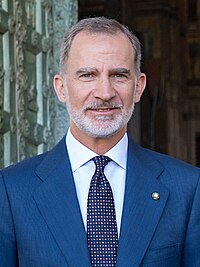Monarchy of Spain
Constitutional institution and the highest office of Spain / From Wikipedia, the free encyclopedia
Dear Wikiwand AI, let's keep it short by simply answering these key questions:
Can you list the top facts and stats about Monarchy of Spain?
Summarize this article for a 10 years old
The monarchy of Spain or Spanish monarchy (Spanish: Monarquía Española) is the constitutional form of government of Spain. It consist of a hereditary monarch that reigns as the head of state, being the highest office of the country.[1] The current monarch is Felipe VI since 19 June 2014, after the abdication of his father, King Juan Carlos I.
| King of Spain | |
|---|---|
| Spanish: Rey de España | |
 | |
| Incumbent | |
 | |
| Felipe VI since 19 June 2014 | |
| Details | |
| Style | His Majesty |
| Heir presumptive | Leonor, Princess of Asturias |
| First monarch | Isabella I of Castile and Ferdinand II of Aragon (Catholic Monarchs of Spain) |
| Residence | Royal Palace of Madrid (official) Palace of Zarzuela (private) |
| Website | The Spanish Monarchy |
.svg/180px-Escudo_de_España_(mazonado).svg.png) |
|---|
|
|
|
|
|
|
Related topics |
The Spanish monarchy is constitutionally referred to as The Crown (Spanish: La Corona), and it comprises the reigning monarch, his or her royal family, and the Royal Household, which supports and facilitates the sovereign in the exercise of his duties and prerogatives.[2][3] The Royal Family is currently represented by King Felipe VI, Queen Letizia, their daughters Leonor, Princess of Asturias, and Infanta Sofía, and the king's parents, King Juan Carlos and Queen Sofía.
The Spanish Constitution of 1978 re-established[1][note 1] a constitutional monarchy as the form of government for Spain after the end of the Francoist regime and the restoration of democracy in 1977. The 1978 constitution affirmed the role of the king of Spain as the living personification and embodiment of the Spanish State and a symbol of Spain's enduring unity and permanence and is also invested as the "arbitrator and the moderator" of Spanish state institutions.[2][4] Constitutionally, the king is the head of state and commander-in-chief of the Spanish Armed Forces.[2][4] The constitution codifies the use of royal styles and titulary, Royal Prerogatives, hereditary succession to the crown, compensation, and a regency-guardianship contingency in cases of the monarch's minority or incapacitation.[2][4] According to the constitution, the monarch is also instrumental in promoting relations with the "nations of its historical community".[2][4] The king of Spain serves as the president of the Organization of Ibero-American States, representing over 700,000,000 people in twenty-four member nations worldwide.[5][6] Spain and Monaco are the last remaining monarchies on the European Mediterranean coast.
The Spanish monarchy has its roots in the Visigothic Kingdom of Toledo founded after the fall of the Western Roman Empire. Then the Kingdom of Asturias fought the Reconquista following the Umayyad conquest of Hispania in the 8th century. A dynastic marriage between Isabella I of Castile and Ferdinand II of Aragon (the "Catholic Monarchs") united Spain in the 15th century. The Spanish Empire became one of the first global powers as Isabella and Ferdinand funded Christopher Columbus's exploratory voyage across the Atlantic Ocean. The sea route he established paved the way for the Spanish conquest of much of the Americas.
As of 2021, the official budget for the Spanish monarchy is 8.4 million euros, one of the lowest public expenditures for the institution of monarchy in Europe.[7] However, other expenses of the royal house are assumed by different government departments.